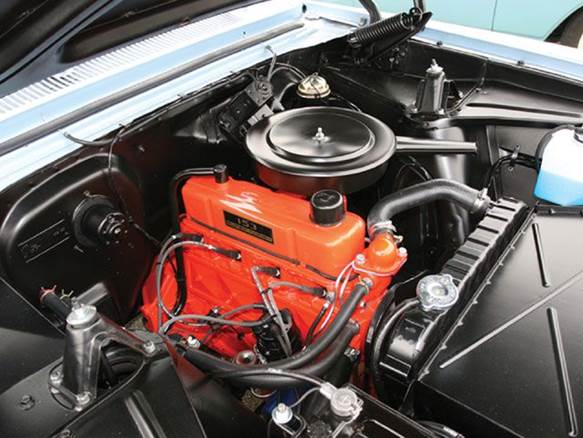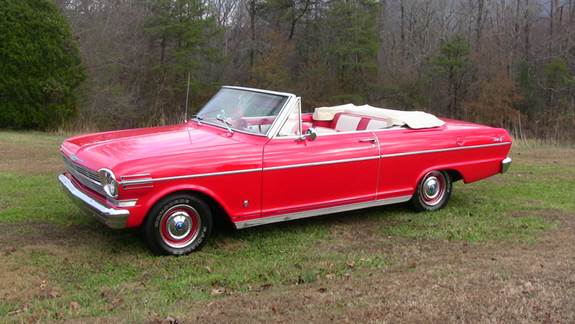On the track
This sweet ash-blue convertible started life with an inline six and a ‘glide. It belonged to a high-school teacher and was billed as “The Wife’s Car.” Now sporting a gorgeous two-tone plush interior and bench seats, the six-banger has been supplanted by an LS1 backed with a 4L60E, and a 10-bolt with 3.36 rear gears. This little Nova wasn’t expected to “turn and burn” at birth, but had some good moments on the Streets of Willow track in the 21st century.
On the day before our testing, Church Boys did a fair bit of suspension tuning to rid the Nova of some unwanted oversteer. They quickly found out that while disconnecting the rear sway bar entirely helped, the Nova needed some light form of lean control to combat a slight feel of disconnect between front and rear. This was mostly apparent in the slalom and was seen as push at mid-corner and track out. Experiencing this at speed was unnerving at first but once it revealed itself, I reverted to the basics of “Brake, Turn, and when we’re finally headed down the track pretty darn straight … Gas it GOOD” for my track laps. This kept the Nova centered and pointed down the track. I adapted as I didn’t want to be the one that had to ex-plain an off-course, furrow-digging excursion with Chevy II.

For track use, I like steering to be precise and have about 2.5 turns lock-to-lock. I’m not fond of the current rack units used for aftermarket front sub-frames as most are too vague with a “soft” feel. I was very happy the steering wheel offered to me was my favored 15-inch diameter, as anything smaller would have made driving the car at speed quite difficult. At slow speeds and in the esses, I found the steering somewhat numb and slow, making turns difficult to navigate and predict.
This improved once speeds increased on faster and wider sweeping turns when the suspension could take a set and accept loading. I found by slowing my corner entry and pre-paring my hands on the wheel, I could get the Nova around and through, “looking” out of the turn earlier, and me on the throttle sooner. This wasn’t easy, mind you, as sliding the car wasn’t an option. I was making use of every inch of track and had no room for error.

If a way could be found to stuff a decent sized tire underneath a Nova, this model of Chevrolet would be the new Camaro. The lack of rubber was the primary factor limiting overall performance and quick times for the Church Boys Nova, and to get even tenths off the clock it meant every turn, each apex, my braking had to be spot-on. Any mistake or lapse in concentration meant precious seconds lost and none gained.
The secondary factor was this little nagging thought that if I got stupid and dropped a wheel off the track, there was a good probability it would suck to be me. No roll bar, a bench seat with little adjustment, lap belts with nary a shoulder harness, and an open-top car does not a good track combination make, and I made sure I didn’t overstep my welcome here. Ten-tenths wasn’t sought nor achieved, as this little Nova wasn’t built for racetrack use. On a cross-country cruise, however … a resounding yes!
My recommendations for Church Boys would be to tighten up the steering feel, add a light rear bar so the car can respond as a single mass o’ metal again, and get the brakes a bit more linear in transition from initial application to smoke-producing lock-up as I walked a fine line here at times. All of these improvements would make this car a delight to drive on any twisty back road.
On the road

This was by far the best car Church Boys has ever brought to our Suspension & Handling Challenge. From a driving standpoint, the steering wheel was just the right diameter, the custom-reupholstered bench seat was supremely comfortable (though not as supportive as race seats for athletic maneuvers), and the powertrain combo (LS1/4L60E) was pretty hard to beat if you don’t mind an automatic transmission – and we don’t (except on track).
Everything about the Church Boys Racing entry just felt right. The ride was supremely comfortable. They’ve happened upon a near ideal combination of spring rates and shock absorbers, etc. On the street portion of our test, we found a truly awful section of road that was smooth on one side of the lane, but broken up for a few hundred feet on the other. Driving with one set of wheels over the rippled, choppy pavement, the Nova never lost its composure. Was it as good as the IRS-equipped ’13 Camaro SS in this regard? No, but it was about a hundred times better than a stock deuce.

The full-size steering wheel allowed the latest rack from CBR to shine. Unlike a too-small wheel, this one showed the rack to be not too fast, not too slow – just right. Praise can also be offered for the coilovers, which delivered an ideal combination of ride comfort and control.
We were very pleased with the way the car performed for us on the street. It was a delicious combination of ride and grip. While it lagged behind the new F-body on the road course, this former econobox surpassed the Camaro SS on the skid-pad (0.89g vs. 0.88g) and equaled it on the slalom (45.5 mph), a testament to the inherent goodness of the parts Church Boys Racing is offering. Were the car equipped with shoulder harnesses and either a roll bar or hard top, Super Chevy’s Stig (Mary) would have gotten a lot more aggressive with her driving. She probably could have lopped seconds off her lap times.
While the CBR Nova wasn’t the quickest car around our Streets of Willow circuit, it had a tremendous level of grip, and we would not have minded driving it anywhere. Those in the market for a cost-effective, suspension solution for their early Chevy II would be wise to consider this setup.
Specifications Price: $5,808 without brakes Type: 2002 5.7L LS1 Fuel Delivery: GM Fuel Injection Transmission: 4L60E Rearend: Factory 10-bolt, with 3:36 gears and a posi Steering: New CBR bolt–in rack-and-pinion conversion Weight: 3,199 |